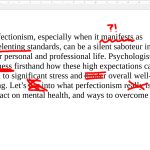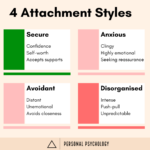Type A personality and the unrelenting standards schema are two distinct psychological constructs, though they share overlapping traits such as perfectionism, high self-expectations, and a relentless drive for achievement. While both can lead to high anxiety and low mood, their origins, manifestations, and psychological implications differ significantly.
Table of Contents
Defining Type A Personality
Type A personality is characterised by competitiveness, time urgency, and a highly strung, achievement-oriented nature. Individuals with this personality type are often described as ambitious, impatient, and highly organised, with a tendency to experience stress more intensely. Research links Type A behaviour to an increased risk of coronary heart disease due to chronic stress responses.
Key traits of Type A personalities include a constant sense of urgency and impatience, a strong desire to outperform others, difficulty relaxing and a tendency to multitask excessively, and high levels of self-criticism when goals are unmet.
Defining Unrelenting Standards Schema
The unrelenting standards schema, rooted in schema therapy, refers to an internalised belief system where individuals impose excessively high, often unrealistic, standards on themselves. Unlike Type A personality, a broad behavioural pattern, this schema is a maladaptive cognitive framework often linked to early childhood experiences.
Core features of the unrelenting standards schema include perfectionism driven by fear of failure or inadequacy rather than mere ambition, chronic feelings of stress and pressure even when goals are met, and avoidance of emotional needs, as strict self-discipline suppresses vulnerability. Additionally, there is a tendency to link self-worth to productivity, leading to burnout.
Overview of Type A Personality and Unrelentind Standards Schema
Type A Personality | Unrelenting Standards Schema | |
|---|---|---|
Primary Driver | External reinforcement (society, family) | Internalised fear of inadequacy/shame |
Root Causes | Genetics and response to competitive demands | Maladaptive coping for emotional safety |
Emotional Components | Stress, impatience, frustration | Chronic self-criticism, fear of failure |
Early Attachment Links | Minimal (not tied to childhood wounds) | Strong (often stems from conditional love) |
Primary Goal of Therapy | Stress reduction, work-life balance | Rewiring deep self-worth beliefs |
Benefits of Therapy | Lowered hostility, improved health | Emotional healing, self-acceptance |
Long-term outcome of Therapy | Sustainable productivity without burnout | Freedom from perfectionism-driven distress and negative self-talk |
Origins of Type-A vs Unrelenting Standards
While both Type A personality and the unrelenting standards schema involve high achievement striving and perfectionism, their developmental roots differ significantly. Understanding these origins helps explain why they manifest differently and require distinct therapeutic approaches.
Origins of Type A personality
Type A personality traits are thought to arise from a combination of biological predispositions and environmental reinforcement, particularly in competitive, fast-paced cultures. Some individuals may possess an innate tendency toward high energy, competitiveness, and time urgency, which are then amplified by environmental pressures. Research has suggested a possible genetic component, particularly in the regulation of dopamine and cortisol, which influences stress reactivity and goal-directed behaviour.
Sociocultural and familial influences also play a crucial role in shaping Type A personality. Children raised in high-achieving families or within cultures that reward productivity and speed may internalise these behaviours from an early age. The reinforcement of a “hustle” culture, especially in corporate or academic environments, further encourages the development of Type A traits. Additionally, observing parents or role models who equate self-worth with productivity can normalise chronic urgency and drive.
Unlike the unrelenting standards schema, Type A personality traits are not necessarily rooted in emotional neglect or maladaptive coping mechanisms. Instead, they often develop as adaptive responses to external demands and societal expectations, reflecting a complex interplay between innate temperament and learned behaviour.
Origins of Unrelenting Standards Schema
The unrelenting standards schema originates primarily from early childhood attachment experiences and develops as a defensive coping mechanism to avoid criticism, shame, or emotional abandonment. This schema is deeply tied to the ways in which children learn to associate their worth with their ability to meet high expectations and avoid emotional vulnerability.
A common root of this schema is conditional love and high parental expectations. Children who receive love, attention, or validation only when they meet strict standards, such as excelling academically or behaving perfectly, come to equate their value with achievement. Similarly, growing up with critical or perfectionist caregivers, who are excessively demanding or punitive, fosters an internalised sense of self-judgment and a persistent drive to meet impossible standards.
Emotional neglect and avoidance also play a significant role. In families where emotions are dismissed or invalidated, children may learn to suppress their vulnerability, adopting perfectionism as a strategy to avoid rejection or disapproval. For some, unrelenting standards serve as a compensatory mechanism, a way to cover up feelings of defectiveness or inadequacy, believing that if they are perfect, their flaws will remain hidden.
Cultural and religious rigidity can further entrench this schema. Upbringings that emphasise strict moral, religious, or cultural rules may instil an all-or-nothing mindset, where anything short of perfection is seen as failure. Unlike Type A personality traits, which can sometimes be adaptive in response to external demands, the unrelenting standards schema is inherently maladaptive. It is driven not just by a desire for achievement, but by an unattainable need for flawlessness in order to feel safe or worthy.
Origins summary
Type A personality is considered a temperamental or behavioural style, possibly influenced by genetic and environmental factors. In contrast, the unrelenting standards schema typically stems from childhood environments where emotions were suppressed, and strict rules were enforced.
Emotional Impact
Type A individuals may experience frustration and impatience but often retain a sense of control. Those with unrelenting standards often feel chronic dissatisfaction, as their self-worth is tied to unattainable ideals.
Behavioural Manifestations
Type A behaviour is outwardly competitive and time-conscious. Unrelenting standards may manifest as compulsive attention to detail, rigidity, or workaholism, often driven by internalised criticism rather than external competition.
Is Type A or Unrelenting Standards Schema the Same as Perfectionism?
While Type A personality, the unrelenting standards schema, and perfectionism all share features of high achievement striving and a desire for excellence, they are not synonymous.
Perfectionism is best understood as a pattern of setting excessively high standards for oneself, accompanied by critical self-evaluation and fear of making mistakes.
Type A personality, on the other hand, is characterized by competitiveness, time urgency, and a drive for productivity, which may or may not include perfectionistic tendencies.
The unrelenting standards schema is a specific maladaptive pattern rooted in early attachment experiences, where self-worth becomes contingent on meeting impossibly high standards to avoid criticism or emotional pain.
Unlike adaptive forms of striving seen in some Type A individuals, perfectionism within the unrelenting standards schema is rigid, driven by fear, and often results in chronic dissatisfaction and stress. Thus, while there is overlap, especially in behaviors, perfectionism is a broader concept that can manifest within both Type A personalities and the unrelenting standards schema, but these constructs each have distinct origins and psychological implications.
Treatment Approaches for Type A Personality vs. Unrelenting Standards Schema
While both Type A personality traits and the unrelenting standards schema involve high achievement striving, their treatment strategies differ due to their distinct psychological roots. A detailed comparison of therapeutic interventions and their respective benefits highlights these differences.
Do you or your loved one need some support? We are here to help!
Treatment for Type A Personality
Type A personality is primarily addressed through stress management and behavioural modification, as it is not considered a pathological condition but rather a temperamental style that can lead to health risks such as hypertension and burnout. One of the most effective interventions is Cognitive-Behavioural Therapy (CBT), which helps individuals recognise and modify stress-inducing thought patterns, including excessive self-criticism and catastrophising. CBT has been shown to reduce hostility and impatience, improve emotional regulation, and lower cardiovascular risk.
Another important approach involves mindfulness and relaxation techniques, such as meditation, deep breathing exercises, and progressive muscle relaxation. These practices are designed to counteract chronic stress responses, enhance present-moment awareness, and reduce urgency-driven behaviour, ultimately improving overall well-being.
Additionally, lifestyle and time management adjustments play a crucial role in managing Type A traits. Encouraging structured breaks, delegation of tasks, and realistic goal-setting help prevent burnout. These strategies promote a balance between productivity and self-care, thereby reducing the risk of long-term health complications associated with a Type A lifestyle.
Treatment for Unrelenting Standards Schema
Since the unrelenting standards schema stems from deep-seated beliefs about self-worth, schema therapy is considered the gold standard for treatment, although other therapeutic modalities can be valuable adjuncts. Schema therapy focuses on identifying and reprocessing early maladaptive schemas through techniques such as limited reparenting, which provides the emotional support that may have been lacking in childhood, and cognitive restructuring, which challenges perfectionistic beliefs. This approach helps reduce self-punishment, fosters self-compassion, and breaks the cycle of tying one’s worth exclusively to achievement.
Emotion-focused techniques are also integral to addressing this schema. These methods, which may include chair work or imagery rescripting, help individuals reconnect with suppressed emotions that are often avoided due to rigid standards. By addressing this emotional avoidance, emotion-focused interventions can reduce chronic anxiety and persistent dissatisfaction associated with the schema.
Finally, behavioural pattern-breaking is an important aspect of treatment. This involves gradually exposing individuals to experiences of “imperfection,” such as deliberately leaving tasks unfinished or accepting mistakes. Over time, this approach builds tolerance for flexibility and reduces compulsive striving, ultimately helping individuals loosen the schema’s hold on their lives.
Please note that this blog post by Personal Psychology, psychologists in North Sydney, and is not intended to provide professional advice. If you or someone you know is experiencing mental health difficulties, it is important to seek help from a qualified healthcare professional.





